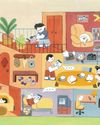
LAST JANUARY, shortly before the who declared covid-19 a pandemic, Sotheby’s in New York put together what was supposed to be a modest auction of a dead interior decorator’s things. Mario Buatta rose up in the 1980s as “the Prince of Chintz,” having decked out the homes of some of America’s wealthiest families (Doubledays, New houses, but also celebrities like Mariah Carey) in the manically floral, overstuffed country- house style of the early nineteenth-century English Regency. If the Regency had steroids and disco, it might have looked more like Buatta’s version of it. At any rate, when he died, in 2018, he left no will, only five storage units and two homes stacked to the ceilings with the types of finds one might imagine belonged to a man who slept on a Chinese four-poster bed crowned by an Ottoman-style dome near columns carved to look like windswept palm trees.
The auction was expected to attract a small crowd of insiders: establishment interior designers, ancient gentry with subscriptions to Town & Country — essentially, the sorts of people who might remember Buatta’s era of more-is-more excess first-hand. Instead, the auction turned into a two-day international selling frenzy. There were feverish bidding wars for just about every item: a dolphin-shaped Venetian grotto stand, a painted tole shell-form purdonium on wheels. An imperfect porcelain tureen shaped like a bunch of asparagus, estimated at between $2,000 and $3,000, went for $25,000 (all figures US).
This story is from the September/October 2021 edition of The Walrus.
Start your 7-day Magzter GOLD free trial to access thousands of curated premium stories, and 8,500+ magazines and newspapers.
Already a subscriber ? Sign In
This story is from the September/October 2021 edition of The Walrus.
Start your 7-day Magzter GOLD free trial to access thousands of curated premium stories, and 8,500+ magazines and newspapers.
Already a subscriber? Sign In

Invisible Lives
Without immigration status, Canada's undocumented youth stay in the shadows

My Guilty Pleasure
"The late nights are mine alone, and I'll spend them however I damn well please"

Vaclav Smil Is Fed Up
The acclaimed environmental scientist is criticizing climate activists, shunning media, and stepping back just when we need him most

It's Time for a Birth Control Revolution
What the pill teaches us about the failure - and future - of women's health care

Would You Watch a Play about Hydro Electricity?
How documentary theatre struck a chord in Quebec

Still Spinning
One record chain has bet big on a new appetite for physical media

Just So You Know, I Love My Mother
In many ways, multi-generational living makes sense. But that doesn't make it easy

Art of the Steal
Why are plundered African artifacts still in Western museums?

Canada in the Middle
What role can we play in easing the war in Gaza?
Canadian Multiculturalism: A Work in Progress
As we mark fifty years since the adoption of Canada’s federal multiculturalism policy, human rights advocate AMIRA ELGHAWABY celebrates its merits and reflects on the work that is yet to be done when it comes to inclusion, acceptance, and fighting systemic racism in our country.